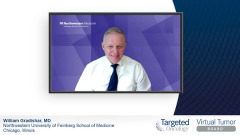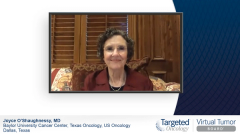
Case 3: The SOPHIA Trial
The experts describe the SOPHIA study of margetuximab in HER2+ advanced breast cancer.
Episodes in this series

Mark Pegram, MD: Just recently the FDA-approved margetuximab, which is a chimeric Fc domain engineered HER2 [human epidermal growth factor receptor 2]–targeting monoclonal antibody. The Fc domain of margetuximab has 5 amino acid substitutions that have been introduced deliberately into the Fc domain amino acid sequence to increase the affinity of margetuximab for activating Fc receptors on NK [natural killer] cells to elicit antibody-dependent cell-mediated cytotoxicity and to decrease the binding affinity to the negative regulatory decoy Fc receptors. That approach was successful in preclinical models. You can see the affinity is there on the right hand side of the slide for the activating vs the inhibitory receptors, is more favorable than trastuzumab. That was the scientific rationale for doing a phase 3 head-to-head comparison of chemotherapy plus trastuzumab vs chemotherapy plus margetuximab to see whether this engineered approach to exploit the immunotherapeutic approach of HER2 antibodies more effectively.
This was the phase 3 pivotal trial design called the SOPHIA. HER2+ breast cancer, 2 or more prior HER2-targeting therapies, including pertuzumab, 1 to 3 prior treatment lines in the metastatic setting, and prior brain metastases were OK if treated and stable. The control arm was investigator choice of chemotherapeutics that are shown. The doses and schedules are shown on the schema as well, and there was stratification by chemotherapy choice prior therapies and number of sites of metastases.
These are the top-line data for the primary end point that won FDA approval, that is the primary end point of progression-free survival. There was a statistically significant improvement in those patients randomized to margetuximab combined with chemotherapy compared with trastuzumab plus chemotherapy, with a hazard ratio of 0.71 and 3 0s after the decimal on the P value. Though this is highly statistically significant, you’ll note that the absolute benefit at the median is modest, just about a 1 month or so change in median PFS [progression-free survival]. This led to further investigation of subsets to determine whether those patients, who have these low-affinity Fc receptor polymorphisms carrying the F allele, might benefit more from margetuximab. There is an exploratory analysis shown on the right-hand side of the slide suggesting that these F allele carriers, if they’re homozygous FF or heterozygous FV at amino acid 158 and CD16A, they appear to get a survival signal from margetuximab, suggesting that this immunotherapy approach may be the basis for the more favorable outcome in this trial. Longer follow-up is needed on this OS [overall survival] for it to be more mature in the future. Maybe we’ll get more long-term follow-up data that it would be more compelling and promising compared with this exploratory interim analysis.
Adverse events were largely infusion reactions. Otherwise, the adverse-event profile is highly similar to trastuzumab, but there is a higher percentage of infusion reactions. Fortunately, most of these are all grade 1 or 2. Most infusion nurses are experienced with managing antibody infusion toxicities that this is easy to manage. Sometimes it may require a slowed rate of infusion or additional administration of some concomitant medications, like antihistamines, to mitigate against some of these infusion-like reactions. Other than the infusion-like reactions, the safety signals were similar, including the cardiac safety signals were superimposable.
Joyce O’Shaughnessy, MD: Thank you, Mark. How do you think we’re going to use margetuximab in our practice? The FDA approval is pretty ne. How do you foresee we’ll start using that in our practice?
Mark Pegram, MD: It’s going to be relegated to the salvage setting because we have many effective therapies, as we’ve highlighted during these case presentations, with the likes of trastuzumab deruxtecan and tucatinib-based therapies. Margetuximab will be saved for later line, when the standard of care used to chemotherapy de jour plus trastuzumab. That will now be converted to chemotherapy of choice plus margetuximab instead of trastuzumab as the backbone.
Joyce O’Shaughnessy, MD: Bill and Adam, what about neratinib in your practice in the metastatic? Of course, we use it in the extended adjuvant, but in the metastatic setting, how do you utilize it now for patients with or without brain metastases?
Adam Brufsky, MD: Until tucatinib came out, the drugs are equivalent in terms of their efficacy even though it hasn’t been proven. Neratinib and tucatinib probably are the same. The major difference is the toxicity, and they deliver a proper dose of neratinib because of the diarrhea. If I use it at all, which is not as common as I used to because of tucatinib, I’ll use it with a dose escalation. There will be a paper showing that a dose-escalation strategy starting at 160 mg and going up to the 240 mg, which is 6 pills over a month, tends to decrease the diarrhea substantially. But we don’t know whether that sacrifices efficacy. Tachyphylaxis is the way to go.
We have tucatinib. The big difference, though, with tucatinib is that we don’t have any data with tucatinib outside capecitabine in combination. We have phase 1 data combined with other chemotherapies. At least with neratinib, we have data from NEfERT-T combining it with paclitaxel. It’s not approved for that indication. That’s 1 thing I’m just a little concerned about as we get into this TKI [tyrosine kinase inhibitor] era. People ask me that question all the time: Can we combine it with other things? I’m going to stick to giving these drugs with capecitabine if I’m going to do it at all. I use a lot less of neratinib than I used to.
One last comment about the margetuximab. It’s fascinating from a scientific standpoint. This concept of Fc receptor manipulation with different IgGs is just in its infancy. We didn’t talk about the CD64 receptor, which is the highest-affinity receptor. I’ve asked this question to MacroGenics, what do these things do to the CD64? Is that important? We don’t know. It is a good proof of concept that manipulation of the Fc receptor does do something. What that is, we’re not sure. I would use margetuximab in much later lines of therapy, and I’ll occasionally use neratinib and MacroGenics in those who don’t tolerate tucatinib.
Joyce O’Shaughnessy, MD: Thanks. Bill, want to add the last word?
William Gradishar, MD: I don’t use a lot of neratinib, probably less than with tucatinib being available. It will be a duel between margetuximab and neratinib in later lines. I talked to our P&T [pharmacy and therapeutics] committee this morning about margetuximab. It’s interesting. Despite the story that Mark weaved about why this drug might work in specific genotypes, the indication was broad. It’s all comers. If you’re HER2+, you can get margetuximab. I was surprised by that. It’s another option available to patients with advanced HER2+ metastatic disease. If they’re doing well, they’ll get used in the late lines.
Joyce O’Shaughnessy, MD: Eighty-six percent of patients have the F allele, so chances are pretty good that maybe more patients will get greater benefit because we’re not looking for the F allele at this moment. Neratinib remains a nice, non-cross-resistant agent, as we’ve seen in the NALA for pretreated patients in the later-line setting with capecitabine or even with paclitaxel if the patient hasn’t had paclitaxel for a while. We do have safety data with paclitaxel or with endocrine therapy, as we’ve seen from the ExteNET study. It does combine for our later-line patients in a non-cross-resistant fashion.
Well, I really enjoyed this. We covered the waterfront really well, looking at lots of new agents and how we can utilize each of them for our patients. Thank you very much for a really lively and thorough discussion. To our viewing audience, thank you for joining us for this Targeted Oncology™ Virtual Tumor Board® presentation. We hope the discussion was a good use of your time and, most important, that it’s valuable to your practice. Thanks very much.
Transcript edited for clarity.
















































